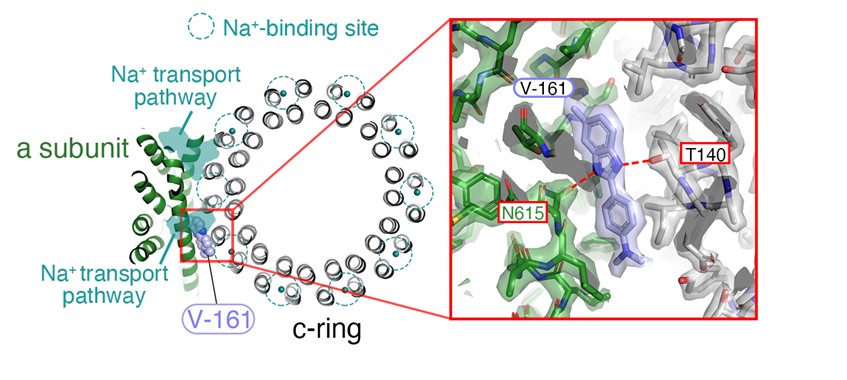V-161 targets a crucial enzyme in VRE, offering promise in combating antibiotic-resistant infections in hospital environments
V-161, a novel compound targeting the Na+-V-ATPase enzyme in vancomycin-resistant Enterococcus faecium (VRE), significantly reduces bacterial growth and colonization. A recent study has demonstrated a promising approach for fighting antibiotic resistance by identifying a compound, V-161, that inhibits a sodium-pumping enzyme critical for VRE survival under alkaline conditions in the intestine while preserving beneficial bacteria. This breakthrough offers hope for treating hospital infections and tackling the global threat of antibiotic-resistant bacteria.

Image title: Structure of the VO domain in Enterococcus hirae V-ATPase enzyme with V-161 inhibitor
Image caption: Researchers from Japan have identified V-161, a compound that inhibits Enterococcus hirae V-ATPase activity, disrupting Na+ transport and effectively inhibiting VRE growth
Image credit: Takeshi Murata from Graduate School of Science, Chiba University, Japan
Image license: Original content
Usage Restrictions: Cannot be used without permission
The rise of antibiotic-resistant bacteria is a global health concern, with studies projecting over ten million deaths annually by 2050 due to these resistant infections. The World Health Organization (WHO) has identified twelve critical antibiotic-resistant pathogens, including vancomycin-resistant Enterococci (VRE), such as Enterococcus faecium (E. faecium). VRE causes severe hospital-acquired infections like endocarditis and sepsis and has developed resistance to multiple antibiotics, highlighting the urgent need for new antimicrobial treatments.
In response to this crisis, a team of researchers led by Professor Takeshi Murata from the Graduate School of Science, Chiba University, Japan, has discovered a promising new compound, V-161, which effectively inhibits the growth of VRE. Their research examined a sodium-pumping enzyme found in these bacteria called Na+-transporting V-ATPase found in E. hirae, a close relative of E. faecium, used as a safer, more tractable model for studying the enzyme. The team consisted of Assistant Professor Kano Suzuki, first author from the Graduate School of Science, Chiba University; Associate Professor Yoshiyuki Goto from the Medical Mycology Research Center, Chiba University; Professor Toshiya Senda and Associate Professor Toshio Moriya from the Structural Biology Research Center, High Energy Accelerator Research Organization; and Professor Ryota Iino from the Institute for Molecular Science, National Institutes of Natural Sciences. This study, published online in Nature Structural & Molecular Biology on November 21, 2024, hypothesized that Na+-transporting V-ATPase could play a key role in the development of an antibiotic that specifically targets VRE without affecting beneficial bacteria.
Dr. Murata explains, “This enzyme helps pump sodium ions out of the cell, aiding in the survival of VRE, especially in alkaline environments like the human gut. This enzyme is absent in beneficial bacteria like lactobacilli, and while humans have a similar enzyme, it serves different functions. This makes the Na+-transporting V-ATPase in VRE an ideal target for selective antimicrobial treatments.” He further states, “We screened over 70,000 compounds to identify potential inhibitors of the enzyme Na+-V-ATPase. Among these, V-161 stood out as a strong candidate, demonstrating significant effectiveness in reducing VRE growth under alkaline conditions—an environment critical for the survival of this resistant pathogen.” Following this, further studies revealed that V-161 not only inhibited the enzyme function but also reduced VRE colonization in the mouse small intestine, highlighting its therapeutic potential.
A major finding of this study was the high-resolution structural analysis of the membrane V0 domain of the enzyme, revealing detailed insights into how V-161 binds to it and disrupts the enzyme function. V-161 targets the interface between the c-ring and the a-subunit of the enzyme, effectively blocking sodium transport. This structural information is critical to understanding the workings of the compound and provides a foundation for developing drugs that target this enzyme.
Dr. Murata explains, “The findings obtained from the structural analysis could be used for the development of treatments for other refractory bacteria and also form a basis for the development of important guidelines for future drug development.” He further adds, “We hope that the development of innovative treatments not only for VRE but also a wide range of drug-resistant bacteria will greatly advance the treatment of drug-resistant infections.”
While the results are promising, the study also notes that further research is needed to make V-161 even more effective and improve its efficacy against a broader range of bacterial strains. Despite these challenges, the findings mark a significant advancement in developing new therapeutic agents to combat VRE and other antibiotic-resistant bacteria. As part of ongoing efforts to refine V-161, the research team plans to test it against other bacterial strains to further assess its potential.
Reflecting on these results, Dr. Murata says, “We hope that these efforts will ultimately
yield more effective treatments for infections caused by VRE and other drug-resistant bacteria, making a significant impact on the fields of infectious diseases and public health.” The ultimate goal is to develop a new class of antibiotics that not only complements existing treatments but may also serve as a powerful solution to combat the escalating threat of antibiotic resistance.
About Professor Takeshi Murata
Dr. Takeshi Murata is a Professor at the Graduate School of Science and the Director of the Membrane Protein Research Center at Chiba University, Japan. He earned his Ph.D. in Engineering from the Tokyo University of Science in 2000. With more than 200 publications, Dr. Murata has received numerous honors, including the Young Researcher Presentation Award at the 49th Symposium of the Society for Bioenergy Research. His research primarily focuses on membrane proteins and structural studies, areas in which he continues to make significant contributions.
Funding:
This work was supported by Grant-in-Aid for Scientific Research, from Japan Society for the Promotion of Science (JSPS), the Research Support Project for Life Science and Drug Discovery (Basis for Supporting Innovative Drug Discovery and Life Science Research (BINDS)) from Japan Agency for Medical Research and Development (AMED), Research Program on ensuring Food Safety from Japanese Ministry of Health, Labour and Welfare, Ministry of Education, Culture, Sports, Science and Technology (MEXT), the grant of OML Project by the National Institutes of Natural Sciences, JST FOREST Program, and by IAAR Research Support Program and Initiative for Realizing Diversity in the Research Environment (T. Murata, K. Suzuki), Chiba University, Japan.
Reference:
Title of original paper: Na+-V-ATPase inhibitor curbs VRE growth and unveils Na+ pathway structure
Authors: Kano Suzuki1,2,3,18, Yoshiyuki Goto3,4,5,6,7,18, Akihiro Otomo8,9, Kouki Shimizu1, Shohei Abe1, Katsuhiko Moriyama1,2,3, Satoshi Yasuda1,2,3, Yusuke Hashimoto10, Jun Kurushima11, Sho Mikuriya1, Fabiana L. Imai1, Naruhiko Adachi12,13, Masato Kawasaki12, Yumi Sato14, Satoshi Ogasawara1,2,3, So Iwata14, Toshiya Senda12,15,16, Mitsunori Ikeguchi17, Haruyoshi Tomita10,11, Ryota Iino8,9, Toshio Moriya12 and Takeshi Murata1,2,3,17
Affiliations:
- Department of Chemistry, Graduate School of Science, Chiba University, Japan
- Department of Quantum Life Science, Graduate School of Science, Chiba University, Japan
- Membrane Protein Research Center, Chiba University, Japan
- Division of Molecular Immunology, Medical Mycology Research Center, Chiba University, Japan
- Division of Pandemic and Post-disaster Infectious Diseases, Research Institute of Disaster Medicine, Chiba University, Japan
- Division of Infectious Disease Vaccine R&D, Research Institute of Disaster Medicine, Chiba University, Japan
- Synergy Institute for Futuristic Mucosal Vaccine Research and Development (cSIMVa), Chiba University, Japan
- Institute for Molecular Science, National Institutes of Natural Sciences, Japan
- Graduate Institute for Advanced Studies, SOKENDAI, Japan
- Department of Bacteriology, Graduate School of Medicine, Gunma University, Japan
- Laboratory of Bacterial Drug Resistance, Graduate School of Medicine, Gunma University, Japan
- Structural Biology Research Center, Institute of Materials Structure Science, High Energy Accelerator Research Organization (KEK), Japan
- Life Science Center for Survival Dynamics, Tsukuba Advanced Research Alliance (TARA), University of Tsukuba, Japan
- Department of Cell Biology, Graduate School of Medicine, Kyoto University, Japan
- School of High Energy Accelerator Science, SOKENDAI, Japan
- Faculty of Pure and Applied Sciences, University of Tsukuba, Japan
- Graduate School of Medical Life Science, Yokohama City University, Japan
- The following authors contributed equally: Kano Suzuki, Yoshiyuki Goto.
Journal: Nature Structural & Molecular Biology
DOI: 10.1038/s41594-024-01419-y
Contact: Takeshi Murata
Professor, Graduate School of Science, Chiba University
Email: t.murata@faculty.chiba-u.jp
Public Relations Office, Chiba University
Email: koho-press@chiba-u.jp
Tel: +81-43-290-2018
Institute for Molecular Science, NINS
Email: press@ims.ac.jp
High Energy Accelerator Research Organization
Email: press@kek.jp
Tel: +81-29-879-6047
The Graduate University for Advanced Studies, SOKENDAI
Email: kouhou1@ml.soken.ac.jp
Tel: +81-46-858-1629
Recommend
-

iPS-NKT Cell Therapy Paves the Way for Revolutionary Cancer Treatments: Bridging Basic Research with Practical Application
2024.11.01
-

Mimicking the 500 million years of plant survival strategies to create a sustainable future
2023.01.14
-

Taking up Immunological Research against Incurable Diseases−The Significance of “1” Life
2023.01.12


